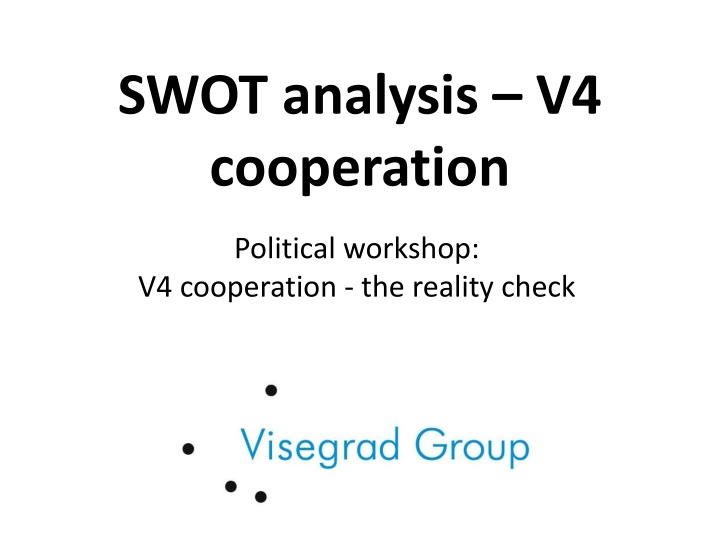V4 Cooperation SWOT Analysis and Stakeholders Overview
Analyzing the strengths, weaknesses, opportunities, and threats of V4 cooperation in the political workshop setting, focusing on the challenges and potential areas for growth. Additionally, examining the key stakeholders involved in the V4 cooperation and their level of influence and interest.
Download Presentation

Please find below an Image/Link to download the presentation.
The content on the website is provided AS IS for your information and personal use only. It may not be sold, licensed, or shared on other websites without obtaining consent from the author.If you encounter any issues during the download, it is possible that the publisher has removed the file from their server.
You are allowed to download the files provided on this website for personal or commercial use, subject to the condition that they are used lawfully. All files are the property of their respective owners.
The content on the website is provided AS IS for your information and personal use only. It may not be sold, licensed, or shared on other websites without obtaining consent from the author.
E N D
Presentation Transcript
SWOT analysis V4 cooperation Political workshop: V4 cooperation - the reality check
SWOT analysis Strengths: common historical and cultural heritage, IVF, membership in international organizations (EU), geographical proximity Threats: multispeed EU, energy dependency from Russia (Russia behavior), no influence of the V4 on the EU level, shift of the investment flow from the central Europe elsewhere, insecure strategic environment, economic instability of the EU and eurozone, decreased weight of the EU on the global scale
SWOT analysis Opportunities: Being recognized as a regional group by the EU, V4+ cooperation, Foreign direct investment, Energy security, Prevention of the brain flow , Supranational coordination authority within V4, Cooperation in the framework of the EU institutions, Tourism, Attraction of brains from outside, Building infrastructure Weaknesses: No common foreign policy, Non-recognition by the EU, Energy vulnerability, Unsettled historical issues, Lack of structure, Under developed infrastructural links between V4 countries, Too general rhetoric of political leaders in declarations, Enlargement (?), Lack of real regional political leaders with concrete will to cooperate
Most important Permanent institution in the V4 Diversification in the energy policy Improving transport infrastructure Common foreign policy Environmental policy Defense spending EU regional policy reform Impossible Possible V4 brand PR Energy infrastructure (interconnectors) Global economic brand Less important
Important stakeholders Less influential and most interested: NGOs, SMEs, think-tanks Most interested and most influential: Russia, Germany, governments, Ministry of Foreign Affairs, OSF, key companies Less influential and less interested: NATO, Committee of Regions, academics Less interested and most influential: international corporations, media, European Commission and European Council, banks























